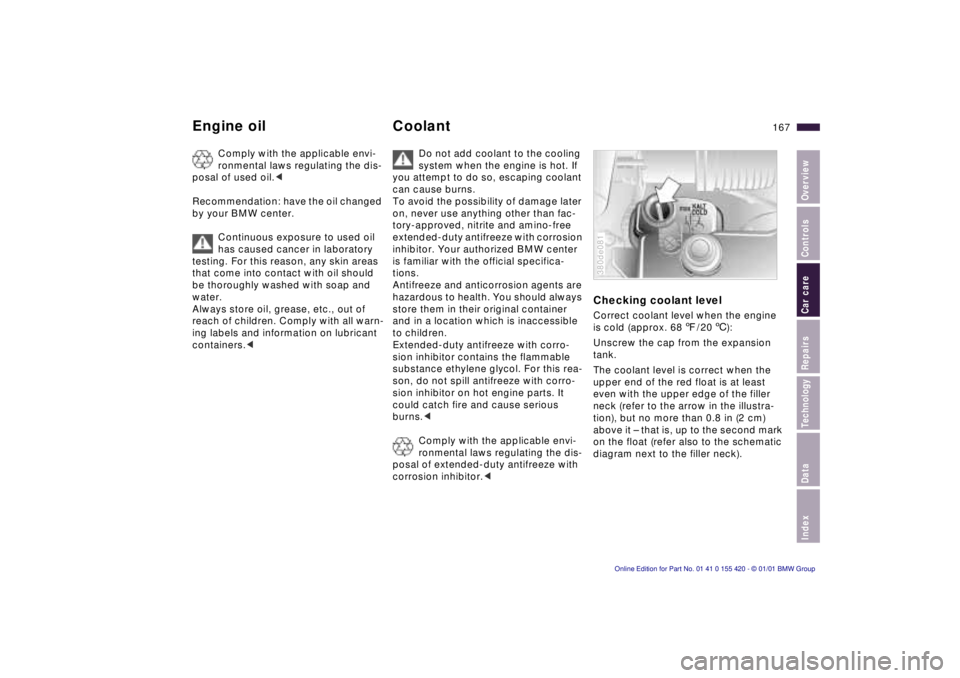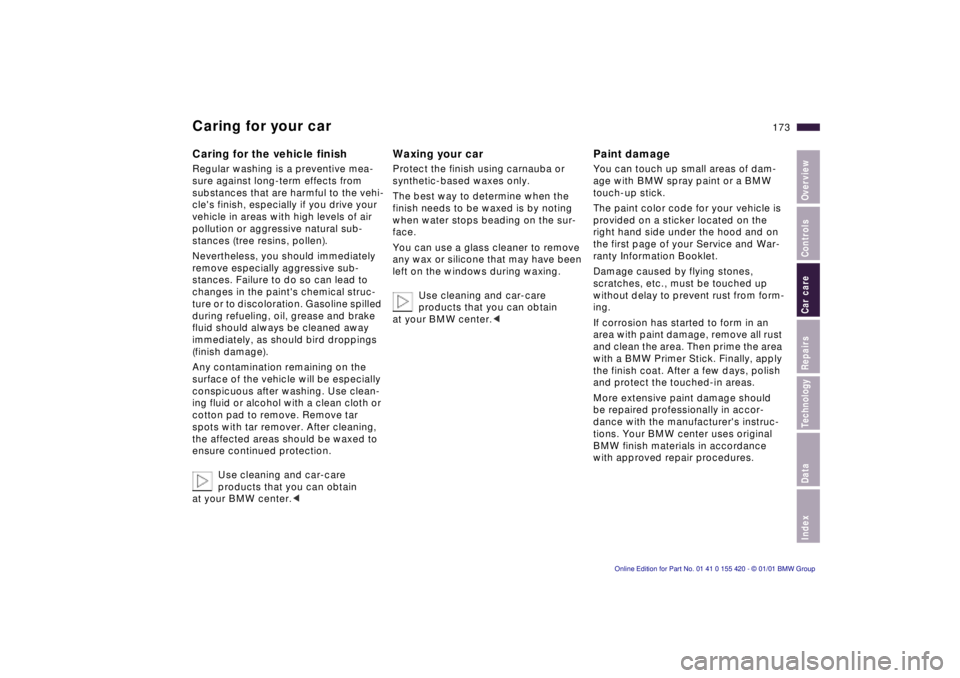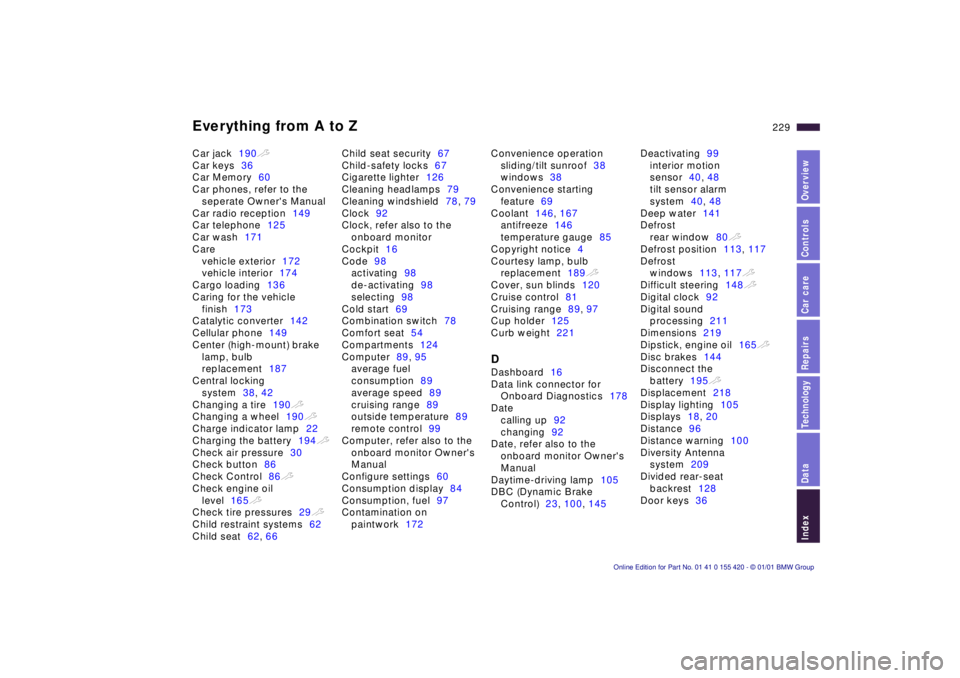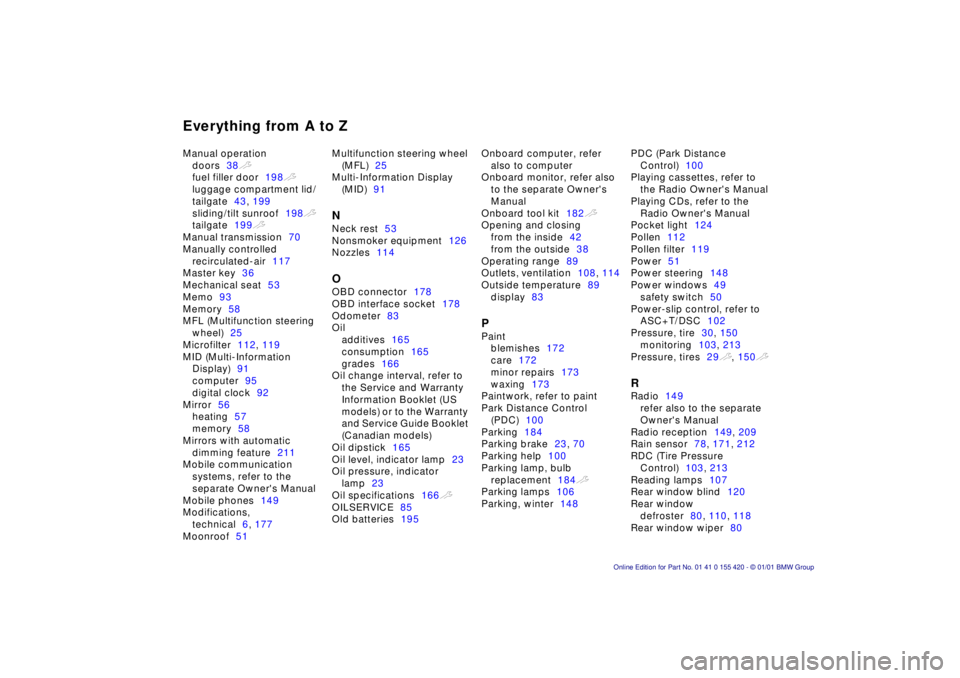2001 BMW 525I SPORT WAGON oil level
[x] Cancel search: oil levelPage 165 of 238

Index
Data
Technology
Repairs
Car care
Controls
Overview
165nEngine oil
Checking oil level
1 Park the vehicle on a level surface.
2 Shut the engine off after it has
reached normal operating
temperature.
3 After approx. 5 minutes, pull the dipstick out and wipe it off with a
clean lint-free cloth, paper towel, or
similar material.
4 Carefully push the dipstick all the way into the guide tube and pull it out
again.
5 The oil level should be in between the
two marks on the dipstick.
As with fuel economy, oil consumption
is directly influenced by your driving
style and vehicle operating conditions.
390de647
The oil volume between the two marks
on the dipstick corresponds to approx.
1.1 US quarts (1 liter). Do not fill beyond
the upper mark on the dipstick. Excess
oil will damage the engine.
460de189
To add oil
Wait until the level has dropped to just
above the lower mark before adding oil.
However, do not wait until the oil level
drops below the lower mark.
BMW engines are designed to op-
erate without oil additives; the use
of additives could lead to damage in
some cases. This is also true for the
manual transmission, the automatic
transmission, the differential, and the
power steering system. <
390de646
Page 167 of 238

Index
Data
Technology
Repairs
Car care
Controls
Overview
167nEngine oil Coolant
Comply with the applicable envi-
ronmental laws regulating the dis-
posal of used oil. <
Recommendation: have the oil changed
by your BMW center. Continuous exposure to used oil
has caused cancer in laboratory
testing. For this reason, any skin areas
that come into contact with oil should
be thoroughly washed with soap and
water.
Always store oil, grease, etc., out of
reach of children. Comply with all warn-
ing labels and information on lubricant
containers. < Do not add coolant to the cooling
system when the engine is hot. If
you attempt to do so, escaping coolant
can cause burns.
To avoid the possibility of damage later
on, never use anything other than fac-
tory-approved, nitrite and amino-free
extended-duty antifreeze with corrosion
inhibitor. Your authorized BMW center
is familiar with the official specifica-
tions.
Antifreeze and anticorrosion agents are
hazardous to health. You should always
store them in their original container
and in a location which is inaccessible
to children.
Extended-duty antifreeze with corro-
sion inhibitor contains the flammable
substance ethylene glycol. For this rea-
son, do not spill antifreeze with corro-
sion inhibitor on hot engine parts. It
could catch fire and cause serious
burns. <
Comply with the applicable envi-
ronmental laws regulating the dis-
posal of extended-duty antifreeze with
corrosion inhibitor. <
Checking coolant level
Correct coolant level when the engine
is cold (approx. 68 7/20 6):
Unscrew the cap from the expansion
tank.
The coolant level is correct when the
upper end of the red float is at least
even with the upper edge of the filler
neck (refer to the arrow in the illustra-
tion), but no more than 0.8 in (2 cm)
above it – that is, up to the second mark
on the float (refer also to the schematic
diagram next to the filler neck).
380de081
Page 172 of 238

172nCaring for your car
Exterior finish
To provide effective corrosion protec-
tion, multilayer paintwork is applied at
the factory. Cataphoretic immersion
priming techniques are supplemented
using special body-cavity protectants,
with the application of specially-devel-
oped and extensively tested materials.
A layer of flexible PVC is first applied to
the undercarriage. Following this, a
comprehensive undercoating treat-
ment with a wax-based protectant is
applied.
Regular maintenance makes an impor-
tant contribution to maintaining the
safety and value of your vehicle.
Increasing awareness of the effects of
harmful environmental factors on vehi-
cle finishes have led paint and vehicle
manufacturers to initiate ongoing pro-
grams designed to further improve the
durability of their finishes. Despite this,
environmental factors that occur locally
or regionally can have negative effects
on the finish of your vehicle. These
should guide you in determining the fre-
quency and extent of your efforts to
maintain the vehicle finish. Depending upon material and type of
impact (perforation of paint layer), phys-
ical stresses from sand, road salt,
gravel, etc., can cause corrosion to
start extending beneath the finish, start-
ing at the point of impact.
Road dirt, tar spots, dead insects, ani-
mal droppings (strong alkali effect) and
tree excretions (resins and pollen) all
contain substances capable of causing
damage when allowed to remain on the
finish of your vehicle for any period of
time (spots, etching, flaking, separation
in the top coat).
In industrial areas, deposits from fly
ash, lime, oil deposits, sulfur-dioxide in
precipitation (acid rain) and other envi-
ronmental pollutants will all damage the
surface of the vehicle unless adequate
protection is provided.
In coastal regions, high levels of
atmospheric salt and humidity promote
corrosion.
In tropical zones, temperatures of over
105
7 (40 6) in the shade prevail, in
addition to heavy ultraviolet radiation
and high humidity. Under those circum-
stances, light exterior finishes reach
temperatures of up to 175 7 (80 6)
and dark finishes up to 250 7 (120 6).
Page 173 of 238

Index
Data
Technology
Repairs
Car care
Controls
Overview
173nCaring for your car
Caring for the vehicle finish
Regular washing is a preventive mea-
sure against long-term effects from
substances that are harmful to the vehi-
cle's finish, especially if you drive your
vehicle in areas with high levels of air
pollution or aggressive natural sub-
stances (tree resins, pollen).
Nevertheless, you should immediately
remove especially aggressive sub-
stances. Failure to do so can lead to
changes in the paint's chemical struc-
ture or to discoloration. Gasoline spilled
during refueling, oil, grease and brake
fluid should always be cleaned away
immediately, as should bird droppings
(finish damage).
Any contamination remaining on the
surface of the vehicle will be especially
conspicuous after washing. Use clean-
ing fluid or alcohol with a clean cloth or
cotton pad to remove. Remove tar
spots with tar remover. After cleaning,
the affected areas should be waxed to
ensure continued protection.
Use cleaning and car-care
products that you can obtain
at your BMW center. <
Waxing your car
Protect the finish using carnauba or
synthetic-based waxes only.
The best way to determine when the
finish needs to be waxed is by noting
when water stops beading on the sur-
face.
You can use a glass cleaner to remove
any wax or silicone that may have been
left on the windows during waxing.
Use cleaning and car-care
products that you can obtain
at your BMW center. <
Paint damage
You can touch up small areas of dam-
age with BMW spray paint or a BMW
touch-up stick.
The paint color code for your vehicle is
provided on a sticker located on the
right hand side under the hood and on
the first page of your Service and War-
ranty Information Booklet.
Damage caused by flying stones,
scratches, etc., must be touched up
without delay to prevent rust from form-
ing.
If corrosion has started to form in an
area with paint damage, remove all rust
and clean the area. Then prime the area
with a BMW Primer Stick. Finally, apply
the finish coat. After a few days, polish
and protect the touched-in areas.
More extensive paint damage should
be repaired professionally in accor-
dance with the manufacturer's instruc-
tions. Your BMW center uses original
BMW finish materials in accordance
with approved repair procedures.
Page 229 of 238

Everything from A to Z
229n
IndexDataTechnologyRepairsCar careControlsOverview
Car jack190
t
Car keys36
Car Memory60
Car phones, refer to the
seperate Owner's Manual
Car radio reception149
Car telephone125
Car wash171
Care
vehicle exterior172
vehicle interior174
Cargo loading136
Caring for the vehicle
finish173
Catalytic converter142
Cellular phone149
Center (high-mount) brake
lamp, bulb
replacement187
Central locking
system38, 42
Changing a tire190
t
Changing a wheel190
t
Charge indicator lamp22
Charging the battery194
t
Check air pressure30
Check button86
Check Control86
t
Check engine oil
level165
t
Check tire pressures29
t
Child restraint systems62
Child seat62, 66Child seat security67
Child-safety locks67
Cigarette lighter126
Cleaning headlamps79
Cleaning windshield78, 79
Clock92
Clock, refer also to the
onboard monitor
Cockpit16
Code98
activating98
de-activating98
selecting98
Cold start69
Combination switch78
Comfort seat54
Compartments124
Computer89, 95
average fuel
consumption89
average speed89
cruising range89
outside temperature89
remote control99
Computer, refer also to the
onboard monitor Owner's
Manual
Configure settings60
Consumption display84
Consumption, fuel97
Contamination on
paintwork172Convenience operation
sliding/tilt sunroof38
windows38
Convenience starting
feature69
Coolant146, 167
antifreeze146
temperature gauge85
Copyright notice4
Courtesy lamp, bulb
replacement189
t
Cover, sun blinds120
Cruise control81
Cruising range89, 97
Cup holder125
Curb weight221
D
Dashboard16
Data link connector for
Onboard Diagnostics178
Date
calling up92
changing92
Date, refer also to the
onboard monitor Owner's
Manual
Daytime-driving lamp105
DBC (Dynamic Brake
Control)23, 100, 145Deactivating99
interior motion
sensor40, 48
tilt sensor alarm
system40, 48
Deep water141
Defrost
rear window80
t
Defrost position113, 117
Defrost
windows113, 117
t
Difficult steering148
t
Digital clock92
Digital sound
processing211
Dimensions219
Dipstick, engine oil165
t
Disc brakes144
Disconnect the
battery195
t
Displacement218
Display lighting105
Displays18, 20
Distance96
Distance warning100
Diversity Antenna
system209
Divided rear-seat
backrest128
Door keys36
Page 230 of 238

Everything from A to Z
Door locks, care146
Doors
emergency release38
manual operation38
t
remote control40
unlocking and locking38
DOT Quality Grades151
Drive belts224
Driving in winter146
Driving notes141
Driving through water141
DSC (Dynamic Stability
Control)24, 102, 208
DSP sound system211
refer also to the Radio
Owner's Manual
Dynamic Brake Control
(DBC)23, 100, 145
Dynamic Stability Control
(DSC)24, 102, 208
E
Electric power seat52
Electric power windows49
Electrical defect
fuel filler door198
t
sliding/tilt sunroof198
t
tailgate199
Electrical heating, exterior
mirror57
Electrical steering wheel,
adjusting56Electrical system224
Electronic vehicle
immobilizer37
Elements of operation16
Emergency operation
doors38
t
fuel filler door198
t
luggage compartment lid/
tailgate43, 199
t
sliding/tilt sunroof198
t
Energy control84
Engine
compartment160
coolant167
Engine oil
consumption165
grades166
level23
pressure22
specifications166
t
Engine specifications218
Error indicators86
Estimated time of arrival97
Exterior finish172
Exterior mirror56
electrical heating57
Exterior mirror with
automatic dimming
feature211
F
Failure messages86
t
Failure of an electrical
accessory196
t
Failure warnings86
t
Filler cap cover28
Filling capacities223
Filling the washer
reservoir164
t
First-aid kit27
t
Fittings, tow-starting and
towing201
t
Flashlight124
Flat tire150, 190
t
Fog lamp, bulb
replacement185
t
Footbrake144
Footwell lamps107
bulb replacement189
t
Forward/backward
adjustment, seats52, 55
Front fog lamps106
Front seat adjustment52
Frost protection,
radiator167
Fuel29
gauge84
quality29
tank capacity223
Fuel consumption97
average97
indicator84Fuel filler door, release after
electrical fault198
t
Fuses196
t
, 197
G
Gasoline29
gauge84
quality29
Glove compartment124
bulb replacement189
t
Gross vehicle weight221
H
Handbrake23, 70
Hands-free system125
Hazard warning
flashers27
t
Hazard warning
triangle27
t
Head restraints53
Headlamp covers,
care171
t
, 183
t
Headlamp flasher78
Headlamp washer
system164
Heated seats119
Heated steering wheel120
Heating and
ventilation108, 114
Heating while stopped118
Heating, rapid113
Heavy loads136
Page 231 of 238

Everything from A to Z
231n
IndexDataTechnologyRepairsCar careControlsOverview
Height219
Height adjustment
seats52
steering wheel56
Help with jump
starting200
t
HiFi system211
High beams24
bulb replacement183
t
High Performance Synthetic
Oils166
High-mount brake lamp187
Hood release159
t
Horn25
Hydraulic Brake Assistant,
refer to DBC23, 100, 145
I
Ice warning83
Identification number of the
vehicle169
Identification, tires153
Ignition key36
Ignition lock68
Imprint4
Independent
ventilation94, 120
Independent ventilation,
refer also to the onboard
monitor Owner's Manual
Indicator lamps22
t
Inflation
pressure29
t
, 30, 150
monitoring103, 213
INSPECTION85
Instrument cluster18, 20
Instrument lighting105
Instrument panel20
Instrument panel switch78
Instruments18
Integrated rear
suspension214
Intensive
cleaning78, 79, 164
Interaxle tire rotation152
Interference indicators86
Interference with
car phones149
Interior lamps106
bulb replacement188
t
remote control40
Interior mirror57
with automatic dimming
feature211
Interior motion sensor48
deactivation48
Interior rearview mirror
with automatic dimming
feature57
Interlock68
Intermittent mode78
J
Jack190
t
Jump starting200
t
KKey Memory60
Key, transmitter36
Keys36
Keys with remote control36
Kickdown73, 76LLashing eye136
Leather care175
Length219
Level control
system23, 214
inactive148t
License plate lamps, bulb
replacement188t
Light switch105
Light-alloy wheels156
Lighter126
Lights-on warning105
LIMIT95
Load-securing devices136
Locking and unlocking the
doors38
Louvers108, 114
Low beams105
bulb replacement183tLow-fuel warning lamp84
Lug bolts191
Lug wrench191t
Luggage compartment46
capacity221
hanger46
lamps106
Luggage compartment
lamps, bulb
replacement189t
Luggage compartment lid/
tailgate43
emergency actuation43
opening separately43
remote control41
secure separately43
unlock in case of electrical
fault43t
Luggage space46
Luggage straps46
Lumbar support54
MM+S tires154
Magic Eye194
Maintenance85t, 170t
Malfunction displays86t
Page 232 of 238

Everything from A to ZManual operation
doors38t
fuel filler door198t
luggage compartment lid/
tailgate43, 199
sliding/tilt sunroof198t
tailgate199t
Manual transmission70
Manually controlled
recirculated-air117
Master key36
Mechanical seat53
Memo93
Memory58
MFL (Multifunction steering
wheel)25
Microfilter112, 119
MID (Multi-Information
Display)91
computer95
digital clock92
Mirror56
heating57
memory58
Mirrors with automatic
dimming feature211
Mobile communication
systems, refer to the
separate Owner's Manual
Mobile phones149
Modifications,
technical6, 177
Moonroof51Multifunction steering wheel
(MFL)25
Multi-Information Display
(MID)91
NNeck rest53
Nonsmoker equipment126
Nozzles114OOBD connector178
OBD interface socket178
Odometer83
Oil
additives165
consumption165
grades166
Oil change interval, refer to
the Service and Warranty
Information Booklet (US
models) or to the Warranty
and Service Guide Booklet
(Canadian models)
Oil dipstick165
Oil level, indicator lamp23
Oil pressure, indicator
lamp23
Oil specifications166t
OILSERVICE85
Old batteries195Onboard computer, refer
also to computer
Onboard monitor, refer also
to the separate Owner's
Manual
Onboard tool kit182t
Opening and closing
from the inside42
from the outside38
Operating range89
Outlets, ventilation108, 114
Outside temperature89
display83
PPaint
blemishes172
care172
minor repairs173
waxing173
Paintwork, refer to paint
Park Distance Control
(PDC)100
Parking184
Parking brake23, 70
Parking help100
Parking lamp, bulb
replacement184t
Parking lamps106
Parking, winter148PDC (Park Distance
Control)100
Playing cassettes, refer to
the Radio Owner's Manual
Playing CDs, refer to the
Radio Owner's Manual
Pocket light124
Pollen112
Pollen filter119
Power51
Power steering148
Power windows49
safety switch50
Power-slip control, refer to
ASC+T/DSC102
Pressure, tire30, 150
monitoring103, 213
Pressure, tires29t, 150t
RRadio149
refer also to the separate
Owner's Manual
Radio reception149, 209
Rain sensor78, 171, 212
RDC (Tire Pressure
Control)103, 213
Reading lamps107
Rear window blind120
Rear window
defroster80, 110, 118
Rear window wiper80